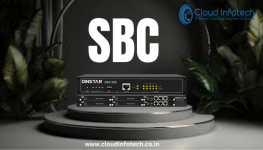- Joined
- Nov 5, 2024
- Messages
- 20
- Reaction score
- 0
- Points
- 1
- Location
- Noida
- Website
- www.cloudinfotech.co.in
- NullCash
- 344
Configuring a Dinstar Session Border Controller (SBC) is essential for ensuring secure and efficient VoIP communications. Below is a step-by-step guide to help you set up your Dinstar SBC effectively.

Step 1: Access the Dinstar SBC Interface
Connect to the Network: Ensure your Dinstar SBC is connected to your network.
Open a Web Browser: Enter the IP address of the Dinstar SBC in the address bar.
Login: Use the default username and password (usually found in the user manual) to log in. Change the default credentials for security purposes.
Step 2: Basic Configuration
Network Settings:
Navigate to the Network settings.
Configure the IP Address, Subnet Mask, and Gateway according to your network requirements.
Set the DNS servers if necessary.
SIP Settings:
Go to the SIP configuration section.
Set the SIP Domain and SIP Port (default is usually 5060).
Configure NAT Traversal settings if your SBC is behind a NAT.
Step 3: Configure SIP Trunks
Add SIP Trunks:
Navigate to the SIP Trunk section.
Click on Add to create a new SIP trunk.
Enter the trunk name, SIP server address, and authentication details (username and password).
Codec Settings:
Select the codecs you want to support (e.g., G.711, G.729).
Set the codec priority based on your requirements.
Step 4: Security Settings
Firewall Configuration:
Enable the firewall settings to protect against unauthorized access.
Configure rules to allow traffic only from trusted IP addresses.
SIP Security:
Enable SIP TLS for encrypted communication.
Configure SRTP for secure media transmission.
Step 5: Routing Configuration
Call Routing:
Go to the Call Routing section.
Define inbound and outbound call routes based on your business needs.
Set up rules for call forwarding, failover, and load balancing if necessary.
Dial Plan:
Configure the dial plan to manage how calls are processed.
Set rules for local, national, and international dialing.
Conclusion
Configuring a Dinstar SBC involves several steps, from basic network settings to advanced security and routing configurations. Always refer to the official Dinstar documentation for specific details related to your model. Regularly update your configuration and firmware to maintain security and performance. If you encounter issues, consult with your network administrator or reach out to Dinstar support for assistance.

Step 1: Access the Dinstar SBC Interface
Connect to the Network: Ensure your Dinstar SBC is connected to your network.
Open a Web Browser: Enter the IP address of the Dinstar SBC in the address bar.
Login: Use the default username and password (usually found in the user manual) to log in. Change the default credentials for security purposes.
Step 2: Basic Configuration
Network Settings:
Navigate to the Network settings.
Configure the IP Address, Subnet Mask, and Gateway according to your network requirements.
Set the DNS servers if necessary.
SIP Settings:
Go to the SIP configuration section.
Set the SIP Domain and SIP Port (default is usually 5060).
Configure NAT Traversal settings if your SBC is behind a NAT.
Step 3: Configure SIP Trunks
Add SIP Trunks:
Navigate to the SIP Trunk section.
Click on Add to create a new SIP trunk.
Enter the trunk name, SIP server address, and authentication details (username and password).
Codec Settings:
Select the codecs you want to support (e.g., G.711, G.729).
Set the codec priority based on your requirements.
Step 4: Security Settings
Firewall Configuration:
Enable the firewall settings to protect against unauthorized access.
Configure rules to allow traffic only from trusted IP addresses.
SIP Security:
Enable SIP TLS for encrypted communication.
Configure SRTP for secure media transmission.
Step 5: Routing Configuration
Call Routing:
Go to the Call Routing section.
Define inbound and outbound call routes based on your business needs.
Set up rules for call forwarding, failover, and load balancing if necessary.
Dial Plan:
Configure the dial plan to manage how calls are processed.
Set rules for local, national, and international dialing.
Conclusion
Configuring a Dinstar SBC involves several steps, from basic network settings to advanced security and routing configurations. Always refer to the official Dinstar documentation for specific details related to your model. Regularly update your configuration and firmware to maintain security and performance. If you encounter issues, consult with your network administrator or reach out to Dinstar support for assistance.
